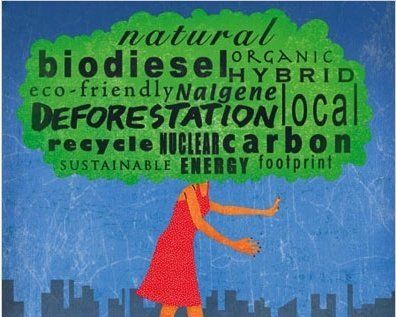
There's a lot of power in guilt. If you live in America and care about the environment, you're likely racked with it daily. There's no escaping the way we live: no matter how much we love mother earth, many of us have to drive to work, dwell in climate controlled offices or homes, throw away the occasional plastic fork, or like Graham Hill, rely on disposable coffee cups when we've forgotten our Thermos in the drying rack. If you suffer from severe environmentally-induced guilt, you may have a condition that once plagued me: green fever.
My green fever nearly destroyed my ability to function without brooding over the state of landfill affairs. I brought Tupperware to restaurants to take my leftovers home without wasting a doggie-bag -- a move that was unappreciated by wait staff and dinner companions alike. Forks and spoons collected crumbs at the bottom of my purse among rusting pennies and crumpled receipts. I offered them to fellow diners whenever I lunched with someone on the run as an alternative to plastic cutlery. I refused to buy anything pre-packaged. For a while I stopped using the gas on my stove. During my months of green fever, I ate many raw vegetables.
I seriously reduced my carbon footprint, no question. But I paid a price. Not only did my efforts make me forlorn and distressed about the rest of the world's waste, but I also started judging my friends and family. I watched loved ones drink bottled water in horror -- even if they subsequently tossed their vessel in the recycling bin. I only drank out of fountains or glass cups. I couldn't stand when my mother bought boxed cereal: what about that plastic bag on the inside?! Not to mention the cardboard box! I only ate raw oats. My boyfriend drove to work -- how lazy. I only traveled by bicycle or on foot.
But, uneasy lies the head that wears the crown of green. Somewhere along the line my cause became a source of alienation. My social life suffered--no cabs for me, thanks. I was nervous and ornery, a pedantic nag. I had become so indignant and polemical in my environmental message that I'd turned people off of going green.
What I learned from my fever was simple: we cannot teach people through stubbornness alone. Sometimes an idea that is so foreign -- as being diligently eco-conscious is to most functioning Americans -- needs to be presented gracefully and through inclusive example rather than by relentless begrudging. As I write this, I'm reminded of a gorgeous Southern belle who once told me in a subtly seductive lilt: "Darlin', you catch more flies with honey."
But of course revolution is difficult, often violent. Changing the way people live in America, where luxury and success are defined by conspicuous consumption, is a harrowing task indeed. So how do we fundamentally alter people's habits through subtle, graceful example? We start by making green trendy. This is happening: Gisele Bündchen is glamorizing the movement in her own leggy, Amazonian way: by starting an environmental blog in charmingly broken English. Even for us anonymous folks with limited sex appeal, there are tricks for making green cool. One example is starting a garden. Serve your foodie friend a Julep with fresh mint from your own windowsill or back yard. He will be impressed, perhaps envious. He may go home and plant a minty patch of his own or one-up you with a bed of lemon verbena. Go with friends to farmer's markets and prepare a simple meal together; the effort will likely lead to more excursions and collaborative cooking.
Of course, if you have green fever, you already know all of the eco-friendly things you can do. The trick is to set an example and include people in your efforts without seeming like you're trying to forcefully convert them. Even if you do silently judge your boyfriend for driving an SUV, remember that telling him what a petroleum pig he is will likely make him less receptive to your green propaganda.
The only way to change the system is from within. Be delicate, clever and coercive, but keep in mind that daily life in America runs a certain way: sometimes it's OK to drive to work, buy a box of Cheerios, or drink coffee from a disposable cup. In my experience, being too stringent in my practices and too didactic in my approach caused people to resist listening, defensive against feeling guilty or at fault. (Hence the "Stop Global Whining" bumper stickers so often plastered to Hummers or Suburbans.) So when it comes to being green, do what you need to do to set an example -- canvas tote, recyclable shoes, Prius, etc. -- but always play it cool.